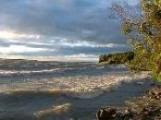Record year for snow and rain for Simcoe
Last night's predicted snowstorm would have pushed Simcoe over the top for the wettest year since record-keeping began in 1930.
Up to 10 centimetres of the white stuff was in the latest Environment Canada forecast for Simcoe. According to Simcoe hydrologist Dr. Harold Schroeter, one centimetre is all that was necessary to set a new 79-year record.
As of press time, Schroeter had measured 183.7 millimetres of precipitation in December at his weather station on Parker Drive. The historic norm for the month is 92.2 mm.
Heading into last night, Schroeter had recorded a total of 1,230.7 mm of precipitation in Simcoe through 2008. This is less than 10 mm behind the record year of 1985, when 1,240 mm were recorded, and less than 6 mm behind 1996, when 1,236.3 mm were recorded.
This month produced the most moisture Schroeter has recorded during his career. His previous high was 178 mm in Guelph in June 1998. That reading included rain from a tornado and heavy thunderstorm that rolled through a section of the city.
No single factor accounts for the large amount of moisture this year. However, the soggy year was helped along by a jet stream that hovered stubbornly over southern Ontario through most of the summer and remnant rainfall from hurricanes Ike and Gustav, which pushed north from the Gulf of Mexico and the Caribbean in early September.
Nearly 200 mm of precipitation in a month is a lot for southern Ontario, but it is nowhere near what nature is capable of.
A 100-year storm in Simcoe is defined as 110 mm of rain in a 24-hour period. The comparable figure for Delhi is 119 mm while the corresponding figure for Toronto is 139 mm.
But hydrologists and meteorologists have taken this concept many steps further. Their computer models have come up with a "maximum probable" storm scenario which posits 300 mm of rain falling in a 24-hour period. This is what's known as a 10,000-year storm.
"That's as much as two months of rain in one day," Schroeter said. "That may not happen in our lifetime, but stranger things are possible."
Despite the large amount of precipitation this year, Lake Erie has hardly budged from the levels it recorded in 2007.
The latest bulletin from the U.S. Army Corps of Engineers says Lake Erie is at a maximum depth of 570.7 feet, one inch shy of its historic average. This is two inches deeper than Lake Erie was on the last day of 2007. USACE doesn't expect the lake's level to change anytime soon.
"Lake Erie is projected to maintain its current level over the next 30 days," USACE's Dec. 26 bulletin says.
This year has been a wet one, but Lake Erie is far below the precipitous levels it achieved in 1986 when the lake rose to 573.8 feet. That year, a horrific storm in February wiped out dozens of cottages on Hastings Drive in Long Point.
Lake Erie is also well above its historic low. The lake sank to 568.2 feet in 1934 during the drought years of the Depression.
Schroeter also reported yesterday that the Environment Canada weather station in Delhi had already recorded the most precipitation in a year in 2008 since record-keeping began there.




1 Comments:
toms outlet store
air jordan retro
cheap authentic jordans
true religion store
ray ban sunglasses
tiffany online
michael kors outlet
retro jordans
oakley sunglasses
true religion
ray ban uk,cheap ray ban sunglasses
air jordan
ray ban sunglasses outlet
oakley sunglasses
Cheap Jordans For Sale
michael kors outlet
cheap jerseys from china
Michael Kors Online Outlet
michael kors outlet
michael kors outlet
nfl jerseys
http://www.chromehearts.com.co
tiffany and co jewellery
michael kors outlet
michael kors handbags outlet
cheap air jordan
christian louboutin outlet
fitflop sandals
chrome hearts online store
kobe shoes
jordans for cheap
Post a Comment
<< Home